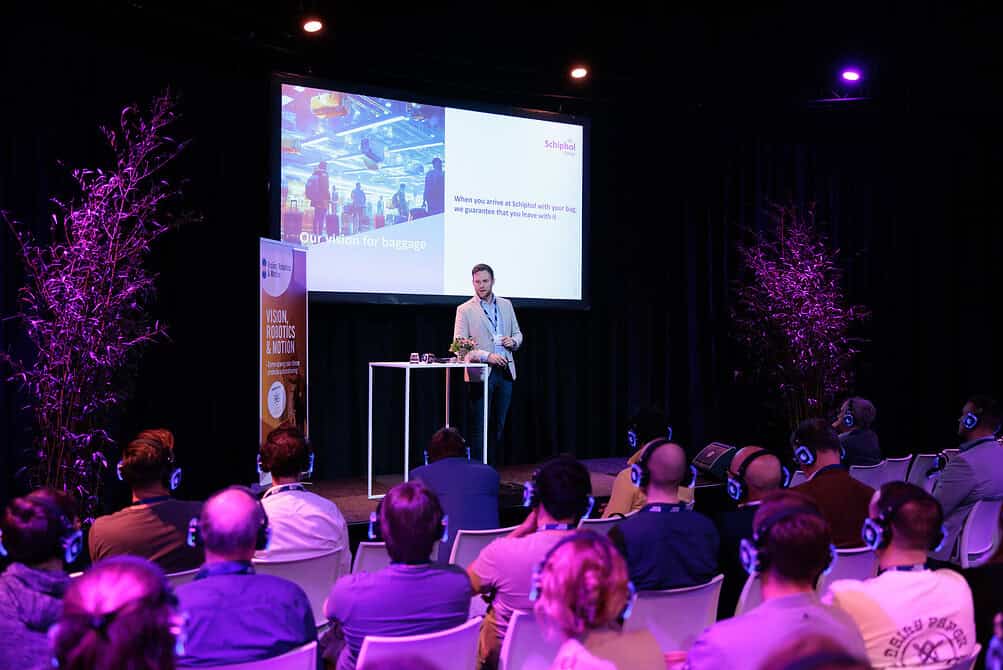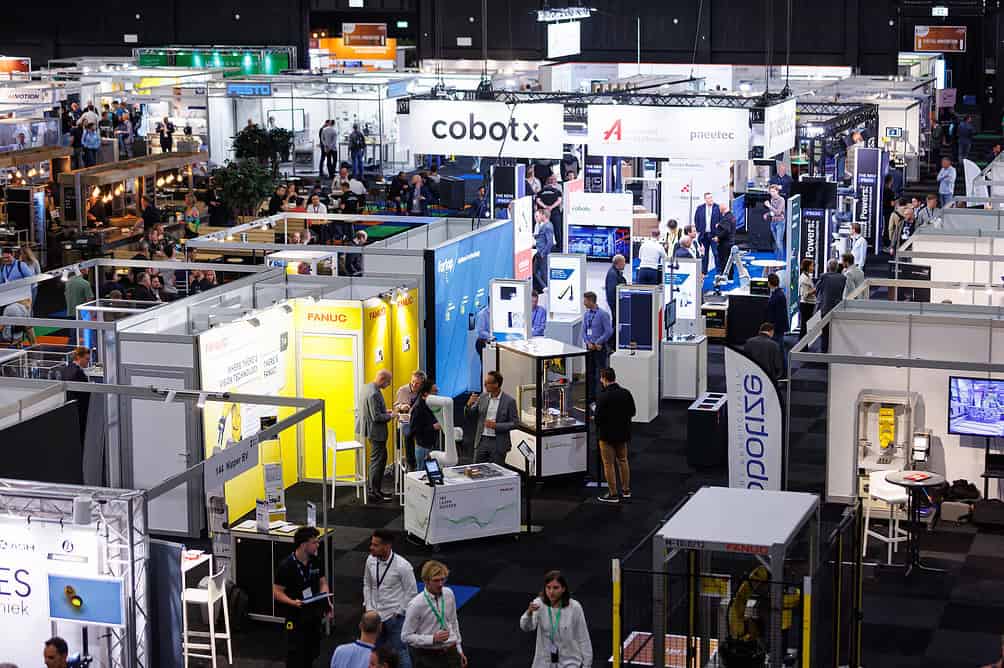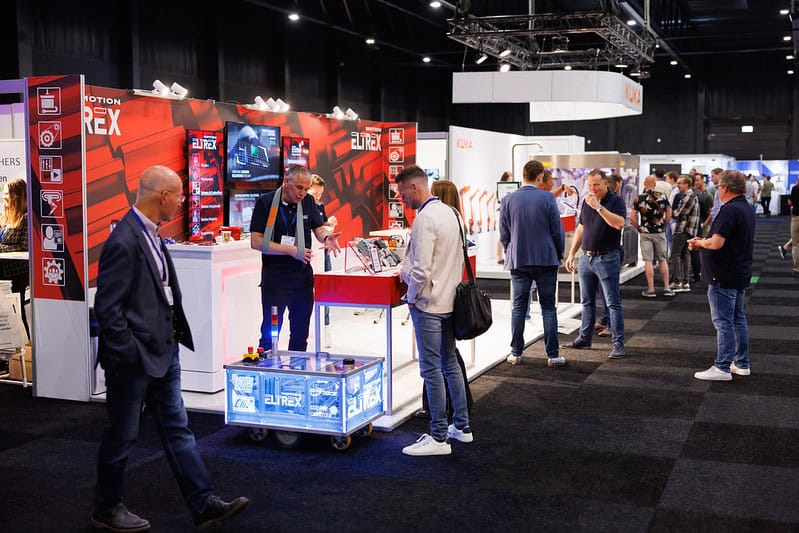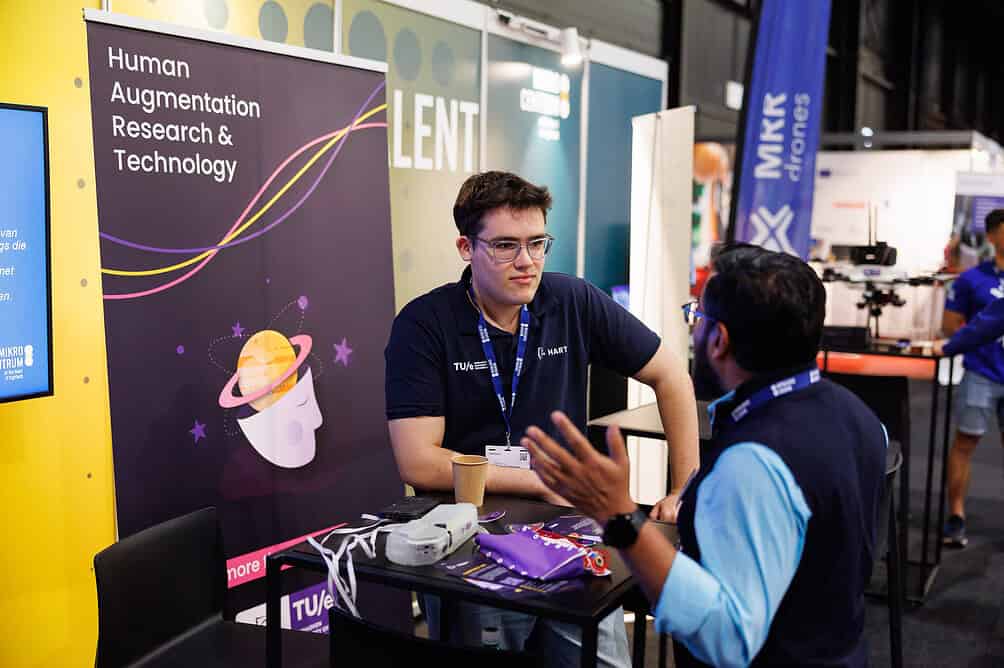
Digitalization, automation, and robotization took center stage at the Vision, Robotics & Motion trade show in Brabanthallen in ‘s-Hertogenbosch last week. The exhibition floor is filled with fast-moving robot arms, autonomous forklifts drive around and soccer robots kick a ball around. During the extensive lecture program, various aspects of digitization and automation are discussed, both in the production environment and in the complete supply chain. A recurring aspect: the role of people in it all.
Why is this important?
Digitalization and automation have a major impact on the manufacturing industry. Developments follow each other in rapid succession. Trade shows such as Vision, Robotics & Motion give professionals an overview of the current possibilities and the trends towards the future.
Better working conditions
Dennis van Kleef, baggage program leader at Schiphol Group, talks in his lecture about the automation of baggage handling at the airport. The Dutch Labour Inspection requires Schiphol to improve working conditions in baggage handling. Time for change, not only because of working conditions but also because of growth. Some of the baggage systems are at the end of their lifespan and will therefore have to be replaced in the next decade. Automation is an important aspect of this to increase capacity, create continuity, and improve working conditions.
The change will come in three layers, Van Kleef outlines. First, there will be lifting assistance for employees. About 80% of the workstations now have this installed. The second horizon is automation and robotization. “This is the source of the solution. Ultimately, people and machines have to work together,” says Van Kleef. In an ideal scenario, robots do the heavy lifting and workers can act as operators. The third layer is all about people; “We need to make sure people take pride in the role they will play in baggage handling.”

Efficient
Dormac Cobots is one of the companies at the fair that is developing so-called cobots – robots that can work together with people. The robotic arms do heavy, routine work such as moving packages. Tjitte de Wolff works for Wadcon on the “grippers” attached to the robotic arms. These work with a vacuum to pick up objects. Most systems suck in air so they can pick up packages. De Wolff is developing a gripper that creates a vacuum with electricity. In this way – compared to the conventional venturi system – about 80% of energy is saved.
In addition to the robots, the fair also focuses on vision technology. Cameras that rapidly scan bar codes on packages, recognize labels, or check packaging for contamination. This technology can improve production chains by ensuring product quality, for example.
From programming to thinking for themselves
For now, the technology used in vision systems and robots is still quite ‘dumb’. “The robots can perform one repetitive task because it is completely pre-programmed. The robots cannot think for themselves,” explains Guido van Gageldonk. They can take over heavy and often boring work from humans – and thus already play an important role in industry. But much more is still possible, observes the program manager of AI and Immersive Technology at the Brabant Development Agency (BOM). “Ultimately, we want to move toward Industry 4.0: a smart industry in which we can make smaller series of different products. Then we need dynamic systems that can switch between different actions and are aware of their surroundings. We cannot program that complexity entirely; the system must then think for itself.”
In this, he sees a frontrunner position for Brabant in applying these new models. “AI is a tool that makes our work more efficient. I see it as a new bicycle. The bicycle gets you to your destination faster, then you’re not going to walk with the bicycle in hand, are you? We have to ride a bicycle. And then we might fall once, but we’ll learn from that.” He urges the companies in attendance to get to work in full force with the possibilities offered by AI.

Enthusiastic or reluctant?
Some companies are already very far along in implementing AI, while others are reluctant, observes Arnoud van der Linden of Mitsubishi Electric Europe. Van der Linden: “My children, teenagers at the moment, are already so used to using ChatGPT. They will enter the job market in a while, and then they will find it the most normal thing in the world to use this technology. When you see how fast ChatGPT has developed and how many people are using it now, we can’t imagine what will happen in the next two years. Development is so fast.”
Feet in the field
Van Gageldonk sees man and machine still working together in the coming years. “We humans stand with our feet in the mud. We see things happening before our eyes and we also oversee the consequences and consequences. The robot lives in a black box; it still has little feeling for the world. Our brains are much more complex than an algorithm. The best chess systems run on a collaboration between a chess computer and a human. That will continue to be the case for the foreseeable future.”

Digital Innovation
AI – and in a broader sense digitalization – is playing a prominent role at Vision, Robotics & Motion for the first time this year. The fair has a new pillar, Digital Innovation, which emphasizes this invisible, but equally important, side of innovation. In his talk, Michiel van Veen, chief supply chain officer at Quooker, outlines the importance of digitalization. Quooker is originally a Dutch family business. The company is growing incredibly fast and the company’s famous boiling water faucet is available in more and more countries. Such strong growth also comes with challenges. How do you organize the production and delivery of materials around the world? Data is crucial, Van Veen outlines. “It is the foundation, without data you cannot drive a chain.”
In addition to the companies, there is also room for young talent. In the special Young Talent Area, student teams get the chance to show their innovations. Team HART from Eindhoven University of Technology (TU/e), for example, is presenting their special sleeve for blind and visually impaired people. “People who cannot see miss a lot of signals in language, for example, body posture and facial expression. The sleeve converts these signals into tactile patterns so that blind and visually impaired people can still experience these forms of language,” explains team captain Giuseppe Vescine.
The power of collaboration
At the fair, various connections are made between companies throughout the chain. Entrepreneurs meet their cooperation partners, suppliers, and customers and make plans together. The power of such an ecosystem is once again emphasized by Dennis van Kleef of Schiphol: “We don’t have all the knowledge ourselves, we have to work together and strengthen each other.”
The next edition of Vision, Robotics & Motion is scheduled for June 11 and 12, 2025 in the Brabanthallen in ‘s-Hertogenbosch.



